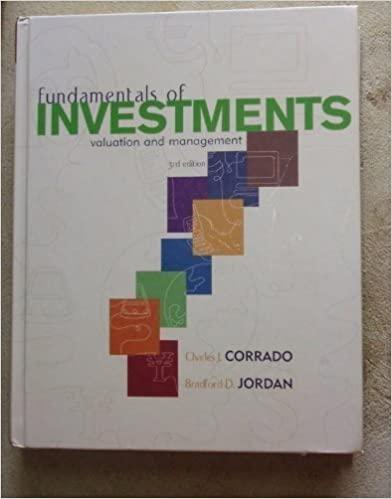Question
1.Travis invested $9,250 in an account that pays 6 percent simple interest. How much more could he have earned over a 7-year period if the
1.Travis invested $9,250 in an account that pays 6 percent simple interest. How much more could he have earned over a 7-year period if the interest had compounded annually?
Select one: a. $773.58 b. $802.16 c. $741.41 d. $833.33
Question 2 Your friend claims that he can double his investment in stocks only 2 years. What would be the annual rate of return if he were successful in doing so?
Select one: a. 41.42% b. 45.58% c. 50.00% d. 100.00%
3.The Smith hamily wishes to buy a new house. The home costs $500,000, and they have saved $75,000 for the down payment. If they wanted to finance the rest with a 15-year fully amortized loan at an APR of 9.6%, what should be the monthly payment if the first payment is due one month from now?
Select one: a. $4,240.80 b. $4,463.64 c. $5,251.34 d. $5,342.74
Question 4)
The principal advantages of the corporate form of organization do not include:
Select one: a. ease of transferability of ownership b. accumulation of earnings for retention in the business c. limited liability of shareholders d. greater accessibility of capital
Question 5 Which of the following would result in a decrease in the net working capital of Smith, Inc?
Select one: a. Smith, Inc. pays one of its accounts payable with cash
b. Smith, Inc. buys inventory using cash
c. Smith, Inc. obtains cash by taking out a bank loan due five years from now
d. Smith, Inc. uses cash to purchase fixed assets
Question 6
Bonner Collision has shareholders' equity of $141,800. The firm owes a total of $126,000 of which 60 percent is payable within the next year. The firm net fixed assets of $161,900. What is the amount of the net working capital?
Select one: a. $75,600 b. $30,300 c. $86,300 d. $25,300
Question 7
Which one of the following statements is correct?
Select one: a. An equity multiplier of 1.2 means a firm has $1.20 in sales for every $1 in equity. b. The debt-equity ratio can be computed as 1 plus the equity multiplier. c. An increase in the depreciation expense will not affect the cash coverage ratio. d. If the total debt ratio is greater than .50, then the debt-equity ratio must be less than 1.0.
Question 8
You want to deposit $2,500 now into a savings account for 5 years. The Simple bank offers 9% per year with simple interest and the Compound bank offers 8% per year with monthly compounding. Which bank would you prefer and why?
Select one: a. The Simple bank because it offers an additional $121.95 in interest. b. The Simple bank because it offers an additional $35.66 in interest. c. The Compound bank because it offers an additional $48.32 in interest. d. The Compound bank because it offers an additional $99.61 in interest.
Question 9
You are comparing two investment options that each pay 5 percent interest, compounded annually. Both options will provide you with $12,000 of income. Option A pays three annual payments starting with $2,000 the first year followed by two annual payments of $5,000 each. Option B pays three annual payments of $4,000 each. Which one of the following statements is correct given these two investment options?
Select one: a. Option B has a higher present value at time zero than does option A. b. Both options are of equal value given that they both provide $12,000 of income. c. Option A has the higher future value at the end of year three. d. Option A is an annuity.
Question 10
Which of the following ratios is the most useful one in assessing a firm's ability to service debts? Select one: a. Fixed asset turnover b. Times interest earned ratio c. Gross profit margin d. Return on equity
Step by Step Solution
There are 3 Steps involved in it
Step: 1

Get Instant Access to Expert-Tailored Solutions
See step-by-step solutions with expert insights and AI powered tools for academic success
Step: 2

Step: 3

Ace Your Homework with AI
Get the answers you need in no time with our AI-driven, step-by-step assistance
Get Started


